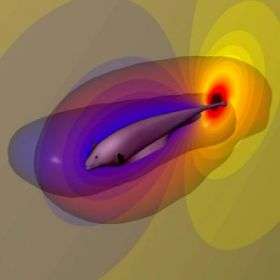A new view on sensing, movement, and behavioral control in animals

While most animals, including humans, preferentially sense and move toward objects that are in front of them, an electric fish from the Amazon called the black ghost knifefish can swim backward or forward to catch its prey.
In a new study published online this week in the open-access journal PLoS Biology, James Snyder and colleagues at Northwestern University investigate the relationship between the energetic costs of the knifefish’s active sensing system—which requires far more energy than passive sensing—and the area over which the animal senses its prey. They propose that the energetic constraints of the knifefish’s active sensing system leads to a restricted sensory space compared to passive-sensing animals.
By combining video analysis of prey capture behavior with computational modeling of the fish’s electrosensory capabilities, the scientists were able to quantify and compare the 3D volumes for sensation and movement for the first time in any animal.
They found that the sensory volume (the size and shape of the space within which objects can be detected by an animal) overlaps the motor volume (the location in space that an animal can reach within a set time period). They suggest that this coupling may arise from constraints that the animal faces when using self-generated energy to probe its environment. They also suggest that the degree of overlap between sensory and movement volumes can provide insight into the types of control strategies that are best suited for guiding behavior.
Citation: Snyder JB, Nelson ME, Burdick JW, MacIver MA (2007) Omnidirectional sensory and motor volumes in electric fish. PLoS Biol 5(11): e301. doi:10.1371/journal.pbio.0050301 (www.plosbiology.org)
Source: Public Library of Science















